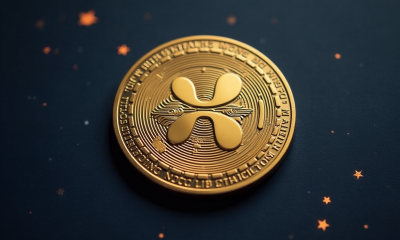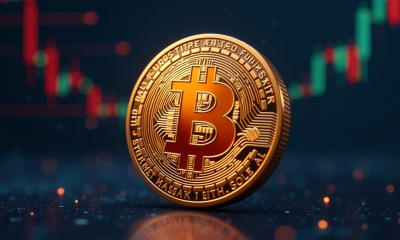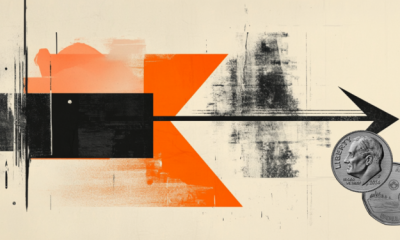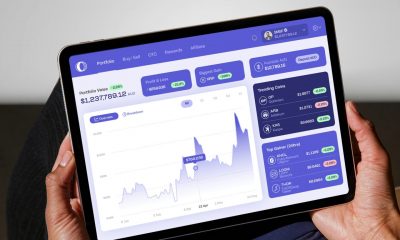

others
USD/INR extends the rally ahead of US GDP data – Crypto News
- Indian Rupee trades softer on the renewed USD demand.
- India is expected to achieve real GDP growth of at least 6–6.5% in the long term, according to a Deutsche Bank report.
- The US Gross Domestic Product (GDP) for the fourth quarter (Q4) will be released later on Wednesday.
Indian Rupee (INR) edges lower on Wednesday amid the modest recovery of the US Dollar (USD). The pair is likely to remain in a tight range due to USD inflows from importers and the potential intervention by the Reserve Bank of India (RBI).
According to the Deutsche Bank report, the Indian economy has shown remarkable resilience, with growth momentum holding up significantly better than expected despite the Russia-Ukraine war last year. Furthermore, India is anticipated to achieve real GDP growth of at least 6–6.5% over the long term. This is considerably higher than in similar developing nations. Investors will take more cues from the Indian GDP annual growth numbers on Thursday, followed by the S&P Global Manufacturing PMI for February on Friday. If the reports show stronger-than-expected results, this might boost the INR and act as a headwind for the USD/INR pair.
Investors will monitor the US Gross Domestic Product (GDP) for the fourth quarter (Q4), due on Wednesday, along with preliminary Goods Trade Balance, Fed’s Bostic, Collins, and Williams speeches. The attention will shift to the Core Personal Consumption Expenditures Price Index (PCE), the Fed’s preferred inflation gauge, due on Thursday.
Daily Digest Market Movers: Indian Rupee remains vulnerable to geopolitical risks
- Traders have speculated that the Reserve Bank of India (RBI) may have been buying Dollars in recent sessions.
- India’s real GDP growth for the December quarter is forecast to grow 7% year-on-year, higher than previously anticipated, according to Deutsche Bank.
- Indian Rupee is likely to have additional support this week from MSCI-rebalancing inflows, which are estimated to drive passive inflows of $1.2 billion into Indian equities, according to Nuvama Alternative & Quantitative Research.
- Foreign investors have net purchased over $2.4 billion of Indian bonds in February so far.
- Fed Governor Bowman said inflation will continue to decline with interest rates held at current levels, but it is not yet time to start lowering rates.
- Kansas City Fed President Schmid stated that there is no need to preemptively adjust the stance of monetary policy as inflation is running above target, labor markets are tight, and demand is showing considerable momentum.
- Financial markets have priced in 80 basis points (bps) of rate cuts this year, lower than 175 bps priced in around mid-January.
Most recent article: Stock Market Today: Nifty and Sensex open marginally higher on Wednesday
Technical Analysis: Indian Rupee oscillates in a longer-term trading band of 82.70–83.20
Indian Rupee trades weaker on the day. USD/INR remains confined within a multi-month-old descending trend channel of 82.70–83.20 since December 8, 2023.
In the near term, the negative outlook of USD/INR remains intact as the pair is below the key 100-day Exponential Moving Average (EMA) on the daily timeframe. Additionally, the 14-day Relative Strength Index (RSI) lies in bearish territory below the 50.0 midline, indicating that a further decline looks favorable.
In the case of a bearish environment, the lower limit of the descending trend channel at 82.70 acts as an initial support level for USD/INR. A breach of this level could put a move to a low of August 23 at 82.45 on the table, followed by a low of June 1 at 82.25.
On the upside, the crucial resistance level for the pair is seen at the confluence of a psychological round mark and the 100-day EMA at 83.00. A break above the mentioned level could attract bullish momentum that may take the pair to the upper boundary of the descending trend channel at 83.20, en route to a high of January 2 at 83.35, and finally at 84.00.
US Dollar price this week
The table below shows the percentage change of US Dollar (USD) against listed major currencies this week. US Dollar was the strongest against the New Zealand Dollar.
| USD | EUR | GBP | CAD | AUD | JPY | NZD | CHF | |
| USD | -0.14% | 0.05% | 0.27% | 0.68% | 0.05% | 1.18% | -0.16% | |
| EUR | 0.13% | 0.17% | 0.40% | 0.82% | 0.19% | 1.32% | -0.01% | |
| GBP | -0.04% | -0.18% | 0.22% | 0.64% | 0.02% | 1.14% | -0.18% | |
| CAD | -0.27% | -0.41% | -0.23% | 0.42% | -0.22% | 0.90% | -0.42% | |
| AUD | -0.70% | -0.83% | -0.63% | -0.42% | -0.63% | 0.50% | -0.84% | |
| JPY | -0.06% | -0.20% | 0.03% | 0.21% | 0.63% | 1.13% | -0.22% | |
| NZD | -1.20% | -1.32% | -1.14% | -0.92% | -0.50% | -1.13% | -1.35% | |
| CHF | 0.15% | 0.00% | 0.19% | 0.42% | 0.85% | 0.20% | 1.31% |
The heat map shows percentage changes of major currencies against each other. The base currency is picked from the left column, while the quote currency is picked from the top row. For example, if you pick the Euro from the left column and move along the horizontal line to the Japanese Yen, the percentage change displayed in the box will represent EUR (base)/JPY (quote).
Indian economy FAQs
The Indian economy has averaged a growth rate of 6.13% between 2006 and 2023, which makes it one of the fastest growing in the world. India’s high growth has attracted a lot of foreign investment. This includes Foreign Direct Investment (FDI) into physical projects and Foreign Indirect Investment (FII) by foreign funds into Indian financial markets. The greater the level of investment, the higher the demand for the Rupee (INR). Fluctuations in Dollar-demand from Indian importers also impact INR.
India has to import a great deal of its Oil and gasoline so the price of Oil can have a direct impact on the Rupee. Oil is mostly traded in US Dollars (USD) on international markets so if the price of Oil rises, aggregate demand for USD increases and Indian importers have to sell more Rupees to meet that demand, which is depreciative for the Rupee.
Inflation has a complex effect on the Rupee. Ultimately it indicates an increase in money supply which reduces the Rupee’s overall value. Yet if it rises above the Reserve Bank of India’s (RBI) 4% target, the RBI will raise interest rates to bring it down by reducing credit. Higher interest rates, especially real rates (the difference between interest rates and inflation) strengthen the Rupee. They make India a more profitable place for international investors to park their money. A fall in inflation can be supportive of the Rupee. At the same time lower interest rates can have a depreciatory effect on the Rupee.
India has run a trade deficit for most of its recent history, indicating its imports outweigh its exports. Since the majority of international trade takes place in US Dollars, there are times – due to seasonal demand or order glut – where the high volume of imports leads to significant US Dollar- demand. During these periods the Rupee can weaken as it is heavily sold to meet the demand for Dollars. When markets experience increased volatility, the demand for US Dollars can also shoot up with a similarly negative effect on the Rupee.
-

 Technology1 week ago
Technology1 week agoBest 5G phones under ₹10,000 in July 2025: Infinix Hot 60, Samsung M06 and more – Crypto News
-

 Technology4 days ago
Technology4 days agoMeet Matt Deitke: 24-year-old AI whiz lured by Mark Zuckerberg with whopping $250 million offer – Crypto News
-
others1 week ago
Japan CFTC JPY NC Net Positions rose from previous ¥103.6K to ¥106.6K – Crypto News
-

 Cryptocurrency5 days ago
Cryptocurrency5 days agoXRP inflows drop 95% since July spike, while Chaikin data signals possible rally – Crypto News
-

 Blockchain5 days ago
Blockchain5 days agoBank of America Sees Interest in Tokenization of Real-World Assets – Crypto News
-

 Blockchain1 week ago
Blockchain1 week agoTether Gold (XAUt) Market Cap Soars as Gold Hits Record Highs in 2025 – Crypto News
-

 Cryptocurrency1 week ago
Cryptocurrency1 week agoMarket update: Bitcoin rises after US-EU announce framework trade agreement – Crypto News
-
others5 days ago
Breaking: Strategy Files $4.2 Billion STRC Offering To Buy More Bitcoin – Crypto News
-
others5 days ago
XRP NIGHT Token Airdrop: Snapshot, Claim Date and What to Expect? – Crypto News
-

 Technology1 week ago
Technology1 week agoWho is Shengjia Zhao? ChatGPT co-creator named Chief Scientist at Meta’s Superintelligence Labs – Crypto News
-
others6 days ago
Ripple Swell 2025: Top Speakers and Panelists to Watch this November – Crypto News
-

 Blockchain6 days ago
Blockchain6 days agoSEC Crypto ETFs Ruling Brings Structural Fix, Not Retail Shakeup – Crypto News
-
Business6 days ago
Breaking: Solana ETFs Near Launch as Issuers Update S-1s With Fund Fees – Crypto News
-

 Technology5 days ago
Technology5 days agoOppo K13 Turbo series confirmed to launch in India with in-built fan technology: Price, specs and everything expected – Crypto News
-
others1 week ago
‘Sit Tight With Bitcoin’ Robert Kiyosaki Predicts Great Depression 2.0 – Crypto News
-
Business1 week ago
Ethereum Breaks $3,900 as SharpLink Makes Another $295M ETH Purchase – Crypto News
-

 Cryptocurrency1 week ago
Cryptocurrency1 week agoBitcoin and Ethereum ETFs Pull in Record-High $11.2 Billion in July – Crypto News
-
Business1 week ago
Breaking: US SEC Delays Launch Of Truth Social’s Bitcoin ETF And Grayscale’s Solana ETF – Crypto News
-

 others1 week ago
others1 week agoBlockchain Gaming Is Growing Up – What’s Behind the Sector’s Quiet Comeback – Crypto News
-

 Business7 days ago
Business7 days agoChase Launches $4 Million Grant Program as Restaurants Struggle – Crypto News
-
Business7 days ago
Stablecoins Won’t Boost Treasury Demand, Peter Schiff Warns – Crypto News
-
Business4 days ago
Bitpanda Co-Founder & Co-CEO Paul Klanschek Steps Down as Firm Eyes Frankfurt IPO – Crypto News
-

 De-fi1 week ago
De-fi1 week agoETH Unstaking Queue Hits Record High, Led by Justin Sun-Linked Addresses – Crypto News
-
Technology1 week ago
Solayer Launches USDC-Powered Hotel Booking Platform To Give Crypto Travel a Boost – Crypto News
-

 others1 week ago
others1 week agoEUR/USD dives as the US Dollar outperforms with all eyes on the Fed decision – Crypto News
-

 Metaverse1 week ago
Metaverse1 week agoOpenAI rolls out ‘Study Mode’ in ChatGPT: What is it? How to use? All your questions answered… – Crypto News
-
Technology1 week ago
Breaking: BlackRock’s Ethereum ETF Staking Proposal Advances As SEC Acknowledges Filing – Crypto News
-
Technology1 week ago
Ethereum Price Prediction- Bulls Target $5,400 Amid DeFi Revival and Soaring TVL – Crypto News
-

 Technology7 days ago
Technology7 days agoIs AI causing tech worker layoffs? Thats what CEOs suggest, but the reality is complicated – Crypto News
-

 De-fi6 days ago
De-fi6 days agoWhite House Crypto Report Recommends Expanding CFTC’s Role in Crypto Regulation – Crypto News
-
Technology6 days ago
Coinbase to Offer Tokenized Stocks and Prediction Markets in U.S. – Crypto News
-

 others6 days ago
others6 days agoCanadian Dollar under pressure amid weak GDP, Trump tariff threat, and strong US data – Crypto News
-

 Technology5 days ago
Technology5 days agoBig Tech’s Big Bet on AI Driving $344 Billion in Spend This Year – Crypto News
-
Cryptocurrency5 days ago
CME XRP Futures Hit Record Highs in July Amid ETF Approval Optimism – Crypto News
-

 Cryptocurrency4 days ago
Cryptocurrency4 days agoStablecoins Are Finally Legal—Now Comes the Hard Part – Crypto News
-
Cryptocurrency3 days ago
Cardano’s NIGHT Airdrop to Hit 2.2M XRP Wallets — Find Out How Much You Can Get – Crypto News
-
Technology3 days ago
Beyond Billboards: Why Crypto’s Future Depends on Smarter Sports Sponsorships – Crypto News
-

 Technology1 week ago
Technology1 week agoIndias startup wave merges AI with tradition for smarter daily solutions – Crypto News
-
others1 week ago
Eurozone CFTC EUR NC Net Positions declined to €125.5K from previous €128.2K – Crypto News
-

 Cryptocurrency1 week ago
Cryptocurrency1 week agoZK breakthroughs, onchain comebacks and stablecoin shakeups – Crypto News
-
Technology1 week ago
Just In: $111B Brokerage Giant Interactive Brokers Explores Stablecoin for Funding – Crypto News
-
others1 week ago
Why Does Jim Cramer Think the Market’s Slow Pace is Actually Good Sign? – Crypto News
-
others1 week ago
Breaking: PayPal to Let Merchants Accept Payments in Over 100 Cryptocurrencies – Crypto News
-

 Blockchain1 week ago
Blockchain1 week agoSEC Gives Green Light to In-Kind Transactions for Crypto ETPs – Crypto News
-

 Technology1 week ago
Technology1 week agoSpotify hits 276M subscribers and strong user growth in Q2, but revenue and profit fall short of targets – Crypto News
-

 Cryptocurrency7 days ago
Cryptocurrency7 days agoAltcoins update: Dogecoin and Injective signal recoveries as Ethereum eyes $4,000 – Crypto News
-

 Technology7 days ago
Technology7 days agoCoinbase exchange targets alleged cybersquatter in lawsuit – Crypto News
-

 Technology6 days ago
Technology6 days agoSolana DEX volume dips 20% after co-founder slams meme coins – Crypto News
-

 Technology6 days ago
Technology6 days agoTim Cook confirms Apple will ramp up AI spending, ‘open’ to acquisitions – Crypto News
-

 Technology5 days ago
Technology5 days agoOppo K13 Turbo series confirmed to launch in India with in-built fan technology: Price, specs and everything expected – Crypto News








